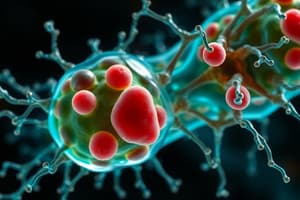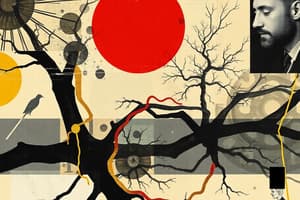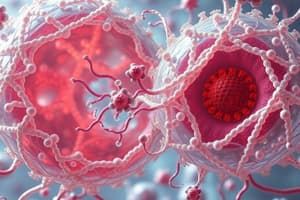Podcast
Questions and Answers
What is the primary function of anterograde transport in cells?
What is the primary function of anterograde transport in cells?
- Isolating proteins within the Golgi complex
- Transporting proteins toward the nucleus
- Facilitating retrograde transport via vesicles
- Moving proteins from the rough ER to the cell membrane (correct)
Which model describes vesicles carrying protein cargo moving from one cisterna to the next?
Which model describes vesicles carrying protein cargo moving from one cisterna to the next?
- Model D
- Model B
- Model A (correct)
- Model C
What conclusion can be drawn from the observation that a cell membrane protein is only found in cisternal sacs and not in associated vesicles?
What conclusion can be drawn from the observation that a cell membrane protein is only found in cisternal sacs and not in associated vesicles?
- Vesicles are essential for anterograde movement
- Proteins exit only through retrograde pathways
- Proteins may move through the Golgi without vesicles (correct)
- Proteins remain static in the Golgi complex
Which feature is unique to Model B in protein transportation through the Golgi?
Which feature is unique to Model B in protein transportation through the Golgi?
What experimental approach can help differentiate between the two models of protein movement in the Golgi complex?
What experimental approach can help differentiate between the two models of protein movement in the Golgi complex?
What does the term 'retrograde transport' refer to in the context of the Golgi complex?
What does the term 'retrograde transport' refer to in the context of the Golgi complex?
What evidence is necessary to support a conclusion about protein movement through the Golgi?
What evidence is necessary to support a conclusion about protein movement through the Golgi?
What is the role of Sec23 and Sec24 proteins in membrane curvature?
What is the role of Sec23 and Sec24 proteins in membrane curvature?
What protein is functionally similar to Sar1 in the formation of COPI and clathrin-coated vesicles?
What protein is functionally similar to Sar1 in the formation of COPI and clathrin-coated vesicles?
What process occurs after the cargo is loaded into the vesicle?
What process occurs after the cargo is loaded into the vesicle?
How do cargo receptors interact with coat proteins during the accumulation of cargo?
How do cargo receptors interact with coat proteins during the accumulation of cargo?
What occurs when ER membrane micelles are incubated with COP II proteins and activated Sar1-GTP?
What occurs when ER membrane micelles are incubated with COP II proteins and activated Sar1-GTP?
Which of the following statements is true regarding the accumulation of cargo in vesicles?
Which of the following statements is true regarding the accumulation of cargo in vesicles?
What happens to Sar1 when GTP is hydrolyzed?
What happens to Sar1 when GTP is hydrolyzed?
What visual representation can be seen when antibodies are used to detect coat proteins?
What visual representation can be seen when antibodies are used to detect coat proteins?
What role do vesicles play in the Golgi complex according to the cisternal maturation model?
What role do vesicles play in the Golgi complex according to the cisternal maturation model?
What happens to the medial-Golgi cisternae as they move through the Golgi complex?
What happens to the medial-Golgi cisternae as they move through the Golgi complex?
What does the cisternal maturation model imply about the formation of new cis-Golgi?
What does the cisternal maturation model imply about the formation of new cis-Golgi?
According to the cisternal maturation model, what happens to Golgi-resident proteins during transport?
According to the cisternal maturation model, what happens to Golgi-resident proteins during transport?
How is cargo moved through the Golgi complex?
How is cargo moved through the Golgi complex?
What is the main characteristic of the cisternal maturation model?
What is the main characteristic of the cisternal maturation model?
What is meant by 'anterograde transport' in the context of the Golgi complex?
What is meant by 'anterograde transport' in the context of the Golgi complex?
What are the implications for the trans-Golgi network according to the cisternal maturation model?
What are the implications for the trans-Golgi network according to the cisternal maturation model?
What happens to dynamin at the restrictive temperature of 30°C?
What happens to dynamin at the restrictive temperature of 30°C?
What is the primary effect of the temperature-sensitive shibire mutation at higher temperatures?
What is the primary effect of the temperature-sensitive shibire mutation at higher temperatures?
How do researchers observe the effects of temperature on the movement of the flies?
How do researchers observe the effects of temperature on the movement of the flies?
What occurs after the temperature is decreased back to a permissive level?
What occurs after the temperature is decreased back to a permissive level?
What is required for the release of neurotransmitters into the recipient compartment?
What is required for the release of neurotransmitters into the recipient compartment?
What temperature do the wildtype flies remain unaffected?
What temperature do the wildtype flies remain unaffected?
What change is observed in flies at 29°C with the shibire mutation?
What change is observed in flies at 29°C with the shibire mutation?
What is the role of dynamin in the context of vesicle formation?
What is the role of dynamin in the context of vesicle formation?
What is the role of NSF and alpha-SNAP in the SNARE complex?
What is the role of NSF and alpha-SNAP in the SNARE complex?
What type of vesicles are involved in anterograde transport from the ER to the Golgi?
What type of vesicles are involved in anterograde transport from the ER to the Golgi?
Why is retrograde transport necessary in the cell?
Why is retrograde transport necessary in the cell?
What sequence is recognized by the KDEL receptor for retrieving ER resident proteins?
What sequence is recognized by the KDEL receptor for retrieving ER resident proteins?
What function do COP I vesicles serve in retrograde transport?
What function do COP I vesicles serve in retrograde transport?
Which sequence is specific for loading into COP I vesicles?
Which sequence is specific for loading into COP I vesicles?
What happens to SNARE proteins once they are disassociated?
What happens to SNARE proteins once they are disassociated?
What is the primary function of the KDEL receptor located in the Golgi complex?
What is the primary function of the KDEL receptor located in the Golgi complex?
What role do COP I vesicles play in protein transport?
What role do COP I vesicles play in protein transport?
Which class of secretory mutants would result from a mutation in a clathrin coat protein?
Which class of secretory mutants would result from a mutation in a clathrin coat protein?
What experimental evidence can support models for vesicle function in protein transport?
What experimental evidence can support models for vesicle function in protein transport?
What happens to ER resident proteins that carry the KDEL signal?
What happens to ER resident proteins that carry the KDEL signal?
Which mechanism was outlined for protein transport away from the ER?
Which mechanism was outlined for protein transport away from the ER?
Flashcards
Anterograde transport
Anterograde transport
The movement of proteins from the rough ER to the cell membrane.
Golgi complex
Golgi complex
A cellular organelle where proteins are modified and packaged before reaching their destinations.
Cis-cisternae
Cis-cisternae
The entry region of the Golgi, closest to the ER.
Medial-cisternae
Medial-cisternae
Signup and view all the flashcards
Trans-cisternae
Trans-cisternae
Signup and view all the flashcards
Model A (Golgi transport)
Model A (Golgi transport)
Signup and view all the flashcards
Model B (Golgi transport)
Model B (Golgi transport)
Signup and view all the flashcards
Immuno-TEM
Immuno-TEM
Signup and view all the flashcards
Cisternal Maturation Model
Cisternal Maturation Model
Signup and view all the flashcards
Golgi Cisternae
Golgi Cisternae
Signup and view all the flashcards
Cis-Golgi
Cis-Golgi
Signup and view all the flashcards
Trans-Golgi
Trans-Golgi
Signup and view all the flashcards
Golgi-resident proteins
Golgi-resident proteins
Signup and view all the flashcards
Vesicles
Vesicles
Signup and view all the flashcards
COPII complex function
COPII complex function
Signup and view all the flashcards
Membrane Curvature
Membrane Curvature
Signup and view all the flashcards
Cargo loading
Cargo loading
Signup and view all the flashcards
Sar1 GTP hydrolysis
Sar1 GTP hydrolysis
Signup and view all the flashcards
Cargo receptors
Cargo receptors
Signup and view all the flashcards
COPII coat protein
COPII coat protein
Signup and view all the flashcards
Vesicle release
Vesicle release
Signup and view all the flashcards
ER resident proteins
ER resident proteins
Signup and view all the flashcards
Dynamin function at different temperatures
Dynamin function at different temperatures
Signup and view all the flashcards
Vesicle formation and neurotransmitter transport
Vesicle formation and neurotransmitter transport
Signup and view all the flashcards
Shibire mutation effect
Shibire mutation effect
Signup and view all the flashcards
Temperature-sensitive paralysis
Temperature-sensitive paralysis
Signup and view all the flashcards
Reversible phenotype
Reversible phenotype
Signup and view all the flashcards
Secretory vesicle docking
Secretory vesicle docking
Signup and view all the flashcards
Neurotransmitter transport in vesicles
Neurotransmitter transport in vesicles
Signup and view all the flashcards
KDEL signal
KDEL signal
Signup and view all the flashcards
COP I vesicle
COP I vesicle
Signup and view all the flashcards
Class E Secretory Mutants
Class E Secretory Mutants
Signup and view all the flashcards
What are the four steps of protein transport?
What are the four steps of protein transport?
Signup and view all the flashcards
How is the Golgi transported?
How is the Golgi transported?
Signup and view all the flashcards
SNARE complex disassembly
SNARE complex disassembly
Signup and view all the flashcards
NSF and alpha-SNAP
NSF and alpha-SNAP
Signup and view all the flashcards
Why retrograde transport?
Why retrograde transport?
Signup and view all the flashcards
KDEL sequence
KDEL sequence
Signup and view all the flashcards
KDEL receptor
KDEL receptor
Signup and view all the flashcards
Study Notes
Module 5, Lecture 2: Vesicular Trafficking
- Proteins leave the rough ER in vesicles, travelling to destinations like the Golgi, lysosome, cell membrane, or secretion.
- Proteins are transported through the Golgi in vesicles and the Golgi complex is composed of flattened sacs called cisternae.
- Vesicles from rough ER move to cis-cisternae of the Golgi, and then to trans-cisternae vesicles from the Golgi.
- Vesicles fuse with the cell membrane, releasing proteins in a process called exocytosis.
- Constitutive secretory pathway releases proteins immediately after synthesis and transport.
- Regulated secretory pathway keeps proteins in the cell until a signal triggers release.
- Secretory granules are vesicles for regulated secretory pathway.
- Endosomes capture and transport macromolecules from outside the cell.
Golgi Complex Structure and Function
- The Golgi complex is a series of flattened sacs called cisternae; not a single organelle.
- The Golgi has different compartments: cis-Golgi network, medial cisternae, and trans-cisternae.
- Cis-Golgi network receives vesicles from the rough ER.
- Medial and trans portions of Golgi further modify proteins.
- Vesicles are continually formed and move through the Golgi.
- There are resident proteins throughout the Golgi.
Protein Transport Pathways
-
Proteins move from the rough ER to the cell membrane through the Golgi complex in anterograde transport.
-
Proteins may be mislocalized and must be transported back to the ER in retrograde transport, involving COPI vesicles.
-
Model A: Vesicles carrying protein cargo move sequentially from cis- to medial- to trans-cisternae.
-
Model B: Cisternae themselves move, while cargo proteins remain in place within cisternae.
-
Experimental evidence supports Model B (cisternal maturation model) - cisternae mature and proteins move through them.
Golgi Cisternal Maturation
- Golgi cisternae are dynamic, changing shape and fusing to form new cisternae.
- New cis-cisternae form from vesicles from the ER.
- Trans-Golgi network contains dispersed vesicles
- Golgi resident proteins are mislocalized in the retrograde direction.
Vesicle Formation
- Vesicle formation occurs through budding from the donor compartment.
- Cargo proteins are loaded into the buds via cargo signaling sequences and receptors.
- Vesicles undergo formation, release, docking, and fusion to the recipient compartment.
- Three types of vesicles are clathrin coated vesicles, COPI coated vesicles and COPII coated vesicles.
Vesicle Release
- GTP hydrolysis by dynamin causes the release of clathrin coated vesicles.
- Dynamin proteins accumulate at the neck of the budding vesicle.
- Dynamin proteins can move and push vesicles via two models: pinchase and poppase.
Dynamin Protein Function
- Dynamin protein is involved in vesicle release.
- Two models are used to describe dynamin function: pinchase model (dynamin constricts the vesicle neck) and pop-pase model (dynamin pushes the vesicle away.)
- Dynamin functions are related to endocytosis as well.
Temperature-Sensitive Dynamin Mutations
- Shibire gene codes for dynamin protein in Drosophila
- Permissive temperature allows wild-type dynamin to function and non-functional dynamin are observed at restrictive temperature.
- Failure in vesicle formation affects neurotransmitter transport and causes paralysis.
Vesicle Fusion
- Vesicle fusion is mediated by SNARE proteins.
- v-SNAREs are on vesicles (example: VAMP), t-SNAREs are on target membranes (example: syntaxin and SNAP25).
- SNARE protein helices bundle and pull membranes together permitting the release of cargo contents.
Protein Transport to ER
- Proteins are sorted back to ER using signals specific to ER resident proteins.
- KDEL sequence is recognized by KDEL receptor in Golgi
- COPI vesicles are used to transport proteins and receptors from the Golgi complex to ER
Summary Notes:
- Experimental data corroborates that the cisternal maturation model (movement of cisternae) is the most likely method of protein transport.
Studying That Suits You
Use AI to generate personalized quizzes and flashcards to suit your learning preferences.




